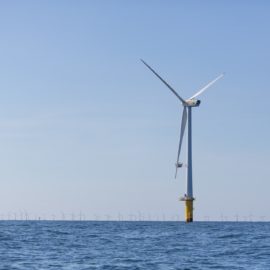
(Dominion Energy)
Virginia has a wind farm off the coast and Louisiana is considering one. Fish are congregating to it and the same should happen here.
In the Atlantic, about 27 miles off the Virginia Beach coast, schools of fish congregate around what looks like a large cylinder covered in algae. Mussels glom onto the structure. Even the occasional sea turtle or giant ocean sunfish pays a visit. The source of this bustling underwater scene is somewhat unlikely — a wind turbine. Dominion Energy’s first two offshore turbines, currently used just for research, have become a haven for marine life. “It’s just amazing the fish ecosystem that is growing around those turbines,” said Scott Lawton, an environmental technical adviser for Dominion.
pilotonline.com
These are big turbines as they are in the Atlantic. The ones in the Gulf might be a bit smaller.
The soaring structures stretch over 600 feet tall, eclipsing the height of the Washington Monument. But the turbine’s steel foundation stretches underwater, too, for about 120 feet. Dominion’s lease area is roughly the size of 85,000 football fields. There are just two pilot turbines, but the company aims to build another 180 for a commercial wind farm by 2026. It first needs several state and federal approvals. The turbines started operating last October. As part of monitoring the site, Dominion took underwater videos of the steel foundation, which is also surrounded by riprap-style rubble on its base — called scour protection. Videos were taken about six months into the project, then again in September. The change in marine life was dramatic, said Mitchell Jabs, a Dominion environmental specialist.
This does not surprise me as when we were stationed in Miami we would go to a Coast Guard Base on the Keys and take a boat out to a off shore light house and fish teemed at its base.
Mussels, algae, mahi, seabass, baitfish and more circle the structure or set up shop directly on it. It’s not just the outside of the foundation, Jabs said. Holes in the turbine to release pressure and allow water to ebb and flow have also led to marine life passing through or residing inside. They’re all “hanging out and feeding on what’s growing on the turbines,” she said. It’s not uncommon. Scientists off the Scandinavian coast have seen underwater turbine foundations gradually transform into artificial reefs, attracting mollusks and small fish that feed on plankton, according to German news channel Deutsche Welle. The effect went “right up the food chain to larger fish, seals and dolphins,” according to the channel. Off the coast of California, an old oil rig is home to a thriving reef.
Ships have been sunk as fish reefs as they provide hard surfaces for plant and animal growth.
Marine animals such as mussels that require hard surfaces normally wouldn’t be out in many parts of the open ocean, though some find rocky bottoms on which to attach, said Mark Luckenbach, associate dean of research and advisory service at the Virginia Institute of Marine Science. The foundations allow those organisms to live. Fish are then attracted to the food source. There’s evidence that reefs with structure can not only attract fish but increase overall populations, he said. But that remains to be seen. The marine science institute is working with Dominion to partner on or design possible scientific studies at the site, including monitoring the turbines’ effects on local fisheries, Luckenbach said.
Construction of the turbines is another story though.
The construction phase of wind farms can be harmful to marine life, causing loud noises and vibrations. Lawton said Dominion uses a “double bubble curtain” as it drives the foundation into the seabed to reduce the sound traveling through the water. Meanwhile, they’re also looking for wildlife above the water: birds and bats that could collide with the blades. Because of their distance to the shore — about two hours by boat — the turbines don’t see a particularly high density of birds. But there are some. The company has mostly documented seabirds in the area so far, including the Northern gannet, through routine boat surveys. Most environmental concerns are about red knots and piping plovers, said Dominion biological consultant Matt Overton. The company hasn’t seen them. Acoustic microphones and video monitoring on the turbines are also supposed to help capture bird and bat activity. The company said it hasn’t seen evidence of a strike. The risk is small, but one always exists, Overton said. Bats have been seen on ships far into the ocean, and some birds migrate from South America over the Atlantic.
Dominion will keep looking into the environmental aspect of these turbines.
The energy company will have to conduct several environmental impact studies through upcoming permitting processes. When officials begin construction on the commercial turbines, they’ll have to plan it around another marine mammal: the endangered North Atlantic right whale.
This would be a good read for those building the turbines in the Gulf. I would imagine the problems are the same and if they take some precautions the uproar will not be as bad.



